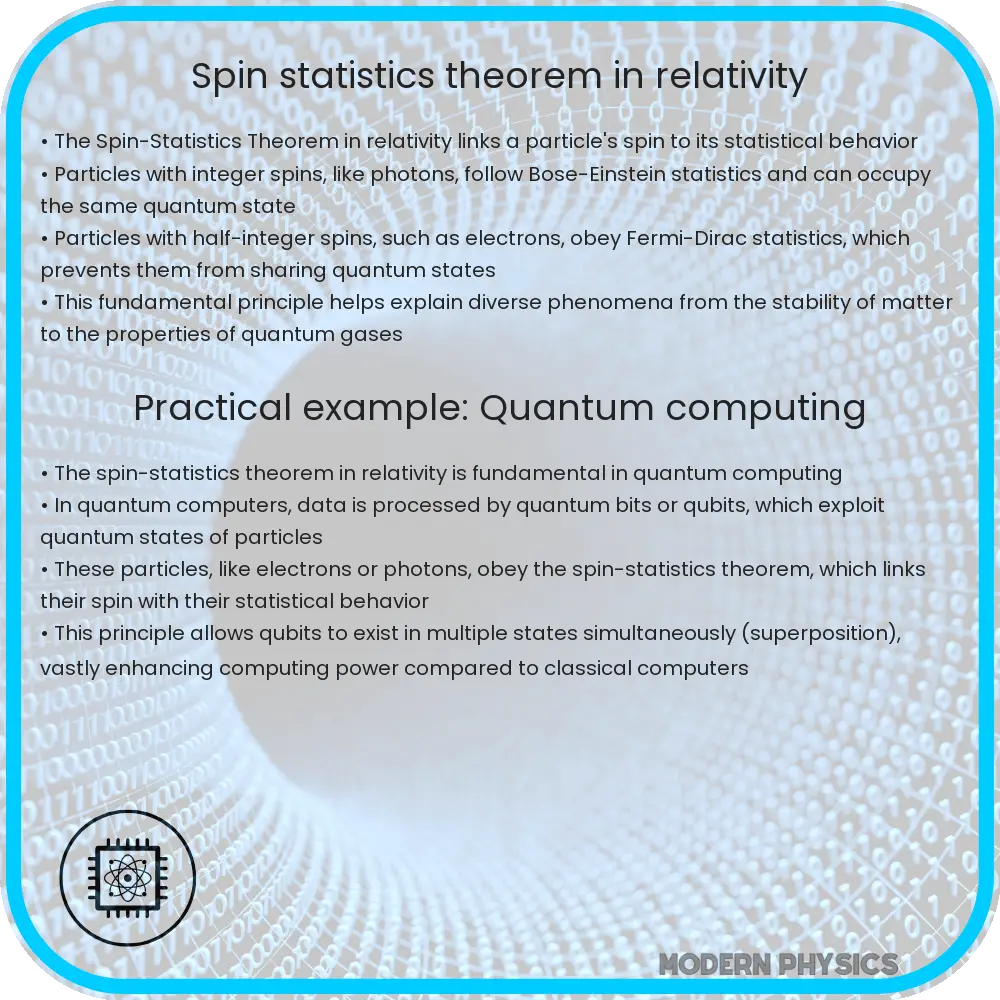An in-depth exploration of the Spin-Statistics Theorem, connecting particle spin with quantum statistics in quantum mechanics.

Understanding the Spin-Statistics Theorem
The Spin-Statistics Theorem is a foundational principle in quantum mechanics that connects the intrinsic angular momentum (spin) of particles with the type of statistics they obey. This theorem has deep implications in both theoretical and applied physics, influencing everything from the structure of atoms to the behavior of quantum fields. Let’s delve into what spin and statistics mean and how they are interrelated through this theorem.
What is Spin in Quantum Mechanics?
In quantum mechanics, spin refers to a fundamental property of particles, much like mass or charge. Unlike these other properties, however, spin describes an intrinsic form of angular momentum carried by particles. It is quantized, meaning that it can only take certain specific values. Particles such as electrons, protons, and neutrons have a spin of 1/2, which means they are fermions, while particles like photons have a spin of 1, classifying them as bosons.
The Symmetry of Particle Types
The universe is fundamentally composed of two types of particles:
- Fermions: These particles have half-integer spins (1/2, 3/2, …). Examples include electrons, protons, and neutrons. Fermions follow Pauli’s exclusion principle, which states that no two fermions can occupy the same quantum state simultaneously. This is crucial for the structure of atoms and the stability of matter.
- Bosons: These particles have integer spins (0, 1, 2, …). Examples include photons and gluons. Bosons do not obey the exclusion principle and can occupy the same quantum state in large numbers, leading to phenomena like Bose-Einstein condensation.
Quantum Statistics: Bose-Einstein and Fermi-Dirac
Associated with these particle types are different statistics that describe how collections of these particles behave:
- Fermi-Dirac statistics apply to fermions, explaining behaviors such as the electronic configuration in atoms and the properties of conductors and semiconductors.
- Bose-Einstein statistics are used for bosons, aiding in understanding phenomena in systems that include lasers and superfluids.
The Core of Spin-Statistics Theorem
The Spin-Statistics Theorem asserts a fundamental rule: particles with integer spin (bosons) must obey Bose-Einstein statistics, and particles with half-integer spin (fermions) must obey Fermi-Dirac statistics. This theorem is central to quantum field theory and is a critical element in the standard model of particle physics, influencing the behavior of all elementary particles.
Why does this matter? Without the Spin-Statistics Theorem, the theoretical framework that predicts how particles interact and form complex structures would not hold, leading to inconsistencies with observed phenomena. For example, if electrons (fermions) did not obey the exclusion principle, atoms as we know them would not exist, drastically altering the universe.
The Origins and Mathematical Foundation of the Theorem
The Spin-Statistics Theorem was first articulated by physicists Wolfgang Pauli and Markus Fierz in the early 20th century. The theorem arises from the principles of quantum theory and the special theory of relativity, requiring a sophisticated understanding of symmetry in physical laws. At its heart, the theorem reflects the fundamental symmetry properties of space-time itself, namely Lorentz invariance, and the permutation symmetry of identical particles.
The mathematical proof of the theorem uses advanced concepts of quantum field theory, particularly the anticommutation relations for fermions and the commutation relations for bosons. These algebraic relationships are crucial in ensuring that the particles behave according to their respective statistics.
Let us now explore how the theorem impacts quantum fields and leads to a predictable and organized framework for understanding particle interactions.
Impact on Quantum Fields and Particle Interactions
The Spin-Statistics Theorem is not just a theoretical curiosity; it has profound implications on the behavior of quantum fields, which are essential for understanding particle physics. Quantum fields are fields that exhibit quantum mechanical properties, including being subject to the principles of quantum statistics. Here’s how the theorem plays a critical role:
- Stability of Matter: The exclusion principle for fermions (arising from Fermi-Dirac statistics) ensures that electrons around a nucleus do not all collapse into the same quantum state, providing the structure and stability of atoms. Without this principle, matter as we know it would not exist.
- Particle Creation and Annihilation: Quantum fields allow for the creation and annihilation of particles. The theorem dictates the statistics of these processes, ensuring that they obey the conservation laws and principles of quantum mechanics, critical for the predictions of particle physics.
- Blackbody Radiation: The distribution of energy levels in bosons, described by Bose-Einstein statistics, explains phenomena like blackbody radiation and the spectral characteristics of stars, which are cornerstone observations in astrophysics.
Real-World Applications
Understanding the spin and statistics of particles also leads to groundbreaking applications in technology and industry. Some notable examples include:
- Semiconductors: The electronic properties of semiconductors are directly influenced by Fermi-Dirac statistics. This fundamental understanding is crucial for designing electronic devices such as transistors and solar cells.
- Superconductivity and Superfluidity: Both of these phenomena rely on Bose-Einstein condensation of bosons. This knowledge is pivotal in developing technologies like magnetic levitation trains and ultra-sensitive magnetic sensors.
- Laser Technology: Lasers operate based on the principles of bosons occupying the same energy state, a concept derived from Bose-Einstein statistics. This is essential in numerous applications, from medical surgeries to communication technologies.
Each of these applications not only improves our daily lives but also pushes the boundaries of what is possible in science and technology.
Conclusion
The Spin-Statistics Theorem serves as one of the pillars of modern physics, bridging abstract theoretical concepts with tangible scientific phenomena and real-world applications. By tying the intrinsic properties of particles—spin and statistics—to the overarching behavior of these particles in quantum fields, this theorem not only enhances our understanding of the universe at a fundamental level but also enables various technological advancements. Whether it’s the stability of matter, the behavior of quantum fields, or the development of innovative technologies, the implications of the Spin-Statistics Theorem continue to influence multiple aspects of science and engineering, proving its indispensability in the realm of quantum mechanics.
